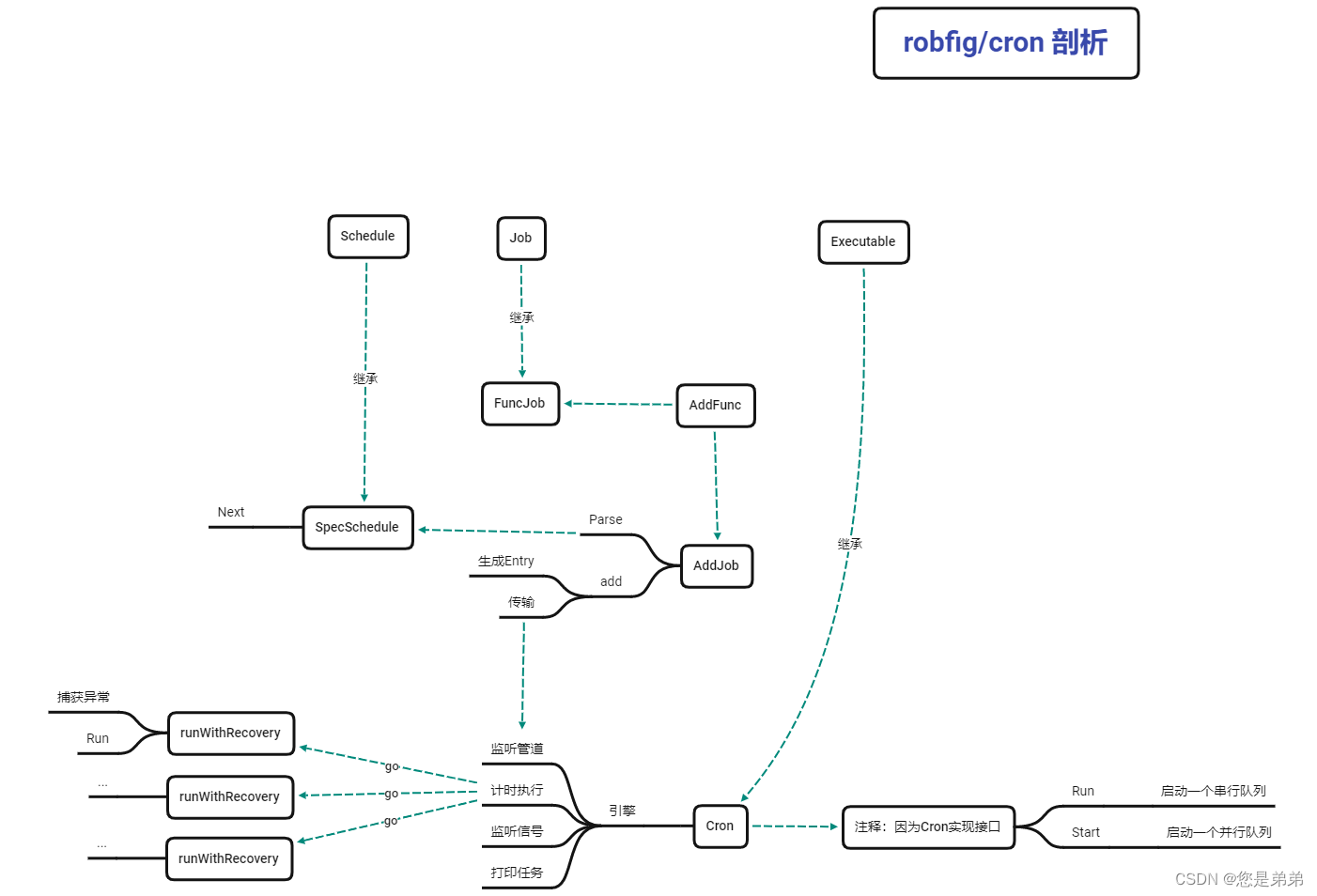Cron深度解析
思想
对于cron 这个三方库来说,他可以说是做两件事,其一是:解析cron string,生成一个定时器,达到循环时间发送信号。其二是核心(引擎):用以执行,判断,接收任务,停止cron等事情。
robfig/cron at v3.0.1架构图

关键位置分析
Cron 实现 Executable 接口
Executable 接口 有三个方法,Cron结构体继承。
- 通过Start 会 启动一个并行队列
- 通过Run 会启动一个串行队列
// Start the cron scheduler in its own go-routine, or no-op if already started.
func (c *Cron) Start() {
if c.running {
return
}
c.running = true
go c.run()
}
// Run the cron scheduler, or no-op if already running.
func (c *Cron) Run() {
if c.running {
return
}
c.running = true
c.run()
}
Cron 结构体分析
// Cron keeps track of any number of entries, invoking the associated func as
// specified by the schedule. It may be started, stopped, and the entries may
// be inspected while running.
type Cron struct {
entries []*Entry
stop chan struct{}
add chan *Entry
snapshot chan []*Entry
running bool
ErrorLog *log.Logger
location *time.Location
}
- entries:指针切片,用以执行当中的entry(即每一个任务)以及接收传进来的任务
- stop:停止信号
- add:接收传输管道
- snapshot:entries 副本,打印需要
cron string 解析
在 AddJob 方法中,通过Parse 函数获取实现了Schedule 接口的结构体:SpecSchedule
func parseDescriptor(descriptor string) (Schedule, error) {
switch descriptor {
case "@yearly", "@annually":
return &SpecSchedule{
Second: 1 << seconds.min,
Minute: 1 << minutes.min,
Hour: 1 << hours.min,
Dom: 1 << dom.min,
Month: 1 << months.min,
Dow: all(dow),
}, nil
case "@monthly":
return &SpecSchedule{
Second: 1 << seconds.min,
Minute: 1 << minutes.min,
Hour: 1 << hours.min,
Dom: 1 << dom.min,
Month: all(months),
Dow: all(dow),
}, nil
......
}
// 该结构体实现了 Schedule 接口
type SpecSchedule struct {
Second, Minute, Hour, Dom, Month, Dow uint64
}
引擎解析
// Run the scheduler. this is private just due to the need to synchronize
// access to the 'running' state variable.
func (c *Cron) run() {
// Figure out the next activation times for each entry.
now := c.now()
for _, entry := range c.entries {
entry.Next = entry.Schedule.Next(now)
}
for {
// Determine the next entry to run.
sort.Sort(byTime(c.entries))
var timer *time.Timer
if len(c.entries) == 0 || c.entries[0].Next.IsZero() {
// If there are no entries yet, just sleep - it still handles new entries
// and stop requests.
timer = time.NewTimer(100000 * time.Hour)
} else {
timer = time.NewTimer(c.entries[0].Next.Sub(now))
}
for {
select {
case now = <-timer.C:
now = now.In(c.location)
// Run every entry whose next time was less than now
for _, e := range c.entries {
if e.Next.After(now) || e.Next.IsZero() {
break
}
go c.runWithRecovery(e.Job)
e.Prev = e.Next
e.Next = e.Schedule.Next(now)
}
case newEntry := <-c.add:
timer.Stop()
now = c.now()
newEntry.Next = newEntry.Schedule.Next(now)
c.entries = append(c.entries, newEntry)
case <-c.snapshot:
c.snapshot <- c.entrySnapshot()
continue
case <-c.stop:
timer.Stop()
return
}
break
}
}
}
就是一个循环,循环等,循环加。
改进点
可以发现在这其中并没有写注销某一个定时任务的方法
但是想实现也是比较简单的,加一个case,监听channel,遍历 entries,找到目标,删除掉就ok了
但是既然它不加,应该是有原因的,不加的原因应该是处于经验考虑的吧?





















 302
302











 被折叠的 条评论
为什么被折叠?
被折叠的 条评论
为什么被折叠?








